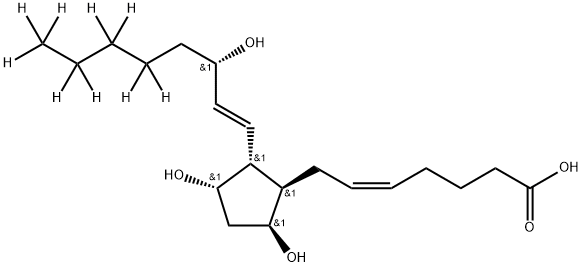INDEX NAME NOT YET ASSIGNED
- CAS No.
- 2738376-79-7
- Chemical Name:
- INDEX NAME NOT YET ASSIGNED
- Synonyms
- CBNumber:
- CB912795175
- Molecular Formula:
- C20H34O5
- Molecular Weight:
- 354.49
- MDL Number:
- MOL File:
- 2738376-79-7.mol
SAFETY
Risk and Safety Statements
| Symbol(GHS) |    GHS02,GHS07,GHS08 |
|||||||||
|---|---|---|---|---|---|---|---|---|---|---|
| Signal word | Danger | |||||||||
| Hazard statements | H225-H319-H360 | |||||||||
| Precautionary statements | P201-P202-P210-P233-P240-P241-P242-P243-P264-P280-P303+P361+P353-P305+P351+P338-P308+P313-P337+P313-P370+P378-P403+P235-P405-P501 | |||||||||
| NFPA 704 |
|
INDEX NAME NOT YET ASSIGNED Chemical Properties,Uses,Production
Description
11β-Prostaglandin F2α-d9 (11β-PGF2α-d9) is intended for use as an internal standard for the quantification of 11β-PGF2α by GC- or LC-MS. 11β-PGF2α is the primary metabolite of PGD2 .1 It is formed from PGD2 via the NADPH-dependent aldo-keto reductase PGF synthase (PGFS; ) in the liver or lung.2 11β-PGF2α induces contraction of isolated cat iris sphincter, which endogenously expresses high levels of PGF2α (FP) receptors, with an EC50 value of 0.045 μM.1 It also induces contraction of isolated human bronchial smooth muscle when used at concentrations ranging from 0.1 to 30 μM.3 11β-PGF2α (0.1 and 1 μM) induces phosphorylation of ERK and CREB, as well as increases the viability of MCF-7 breast cancer cells stably expressing the FP receptor when used at concentrations of 0.1 and 1 μM.4
Uses
9α,11β-Prostaglandin F2α-d9 is the deuterium labeled 9α,11β-Prostaglandin F2α[1].
References
1. Giles, H., Bolofo, M.L., Lydford, S.J., et al. A comparative study of the prostanoid receptor profile of 9α 11 β-
2. Watanabe, K. Prostaglandin F synthase Prostaglandins Other Lipid Mediat. 68-69,401-407(2002).
3. Coleman, R.A., and Sheldrick, R.L.G. Prostanoid-
4. Yoda, T., Kikuchi, K., Miki, Y., et al. 11β-
INDEX NAME NOT YET ASSIGNED Preparation Products And Raw materials
Raw materials
Preparation Products
INDEX NAME NOT YET ASSIGNED Suppliers
| Supplier | Tel | Country | ProdList | Advantage | |
|---|---|---|---|---|---|
| Shanghai Yifei Biotechnology Co. , Ltd. | 021-65675885 18964387627 | customer_service@efebio.com | China | 11973 | 58 |
| Cayman Chemical Company | 800-364-9897 | sales@caymanchem.com | China | 6838 | 58 |
| Supplier | Advantage |
|---|---|
| Shanghai Yifei Biotechnology Co. , Ltd. | 58 |
| Cayman Chemical Company | 58 |





